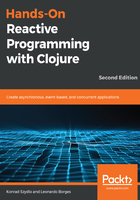
Signals and events
So far, we have been dealing with the idea of programs that react to user input. This is, of course, only a small subset of reactive systems, but is enough for the purposes of this discussion.
User input happens several times through the execution of a program: key presses, mouse drags, and clicks are but a few examples of how a user might interact with our system. All of these interactions happen over a period of time. FRP recognizes that time is an important aspect of reactive programs and makes it a first-class citizen through its abstractions.
Both signals (also called behaviors) and events are related to time. Signals represent continuous, time-varying values. Events, on the other hand, represent discrete occurrences at a given point in time.
For example, time is itself a signal. It varies continuously and indefinitely. On the other hand, a key press by a user is an event, that is, a discrete occurrence.
It is important to note, however, that the semantics of how a signal changes need not be continuous. Imagine a signal that represents the current (x,y) coordinates of your mouse pointer.
This signal is said to change discretely, as it depends on the user moving the mouse pointer—an event which isn't a continuous action.